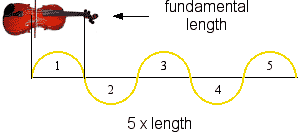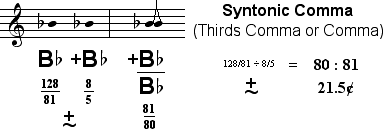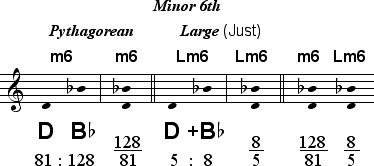
Our system was constructed symmetrically using the first new tone, 3. The idea of symmetry is also used with the second new tone, 5. Considering that the relationship between harmonics 5 and 1 is 5/1, which becomes 5/2 and then 5/4 when placed within the boundaries of 1 and 2, we can use this relationship in reverse to create symmetry around the source tone. The symmetrical tone is not produced by a segment 1/5 as long as the entire string, but rather by a string 5 times as long as the original fundamental. This longer length results in a very low pitch.

The new string does not vibrate 5 times as fast as the source tone, but rather 1/5 as fast. To justify this tone, we have to multiply it by 2, three times, so that 1/5 becomes 2/5, 4/5 and then 8/5, becoming higher in pitch with each duplication.
The second new pitch 5/4 was initially produced above the source tone, and the new pitch 8/5 is initially produced below it, so that these two tones are inversions of each other. Just as 5/4 is shown with an arrow pointing above and to the right from the lower tonic, its inversion 8/5 is shown with opposite orientation from the higher tonic.



The tone 8/5 has an important place in the structure of the Western system. Just as the harmonic mediant 5/4 was produced above the tonic, the harmonic submediant 8/5 is produced below the tonic.

Recall that the names of the 13 tones derived within the 3-limit serve as standards from
which new labels may be derived. The harmonic submediant 8/5 is close to the Minor
Submediant 128/81, B .
.



B is used to label the new tone, but it
obviously does not sound the same as its Pythagorean neighbor. The small interval between
these two tones is another appearance of the Syntonic Comma or Thirds Comma,
found here around the sixth scale degree.
is used to label the new tone, but it
obviously does not sound the same as its Pythagorean neighbor. The small interval between
these two tones is another appearance of the Syntonic Comma or Thirds Comma,
found here around the sixth scale degree.

Because this tone shares a letter and accidental with a Pythagorean tone, a shift
can be used to label the new tone. The plus sign  is used since the new tone is higher than its Pythagorean neighbor. Just as the
prefix sub is used to describe things which are below, the prefix super
is used in standard music theory to describe things which are above. The shift indicating the
higher tone can thus be called a super comma shift, so that
is used since the new tone is higher than its Pythagorean neighbor. Just as the
prefix sub is used to describe things which are below, the prefix super
is used in standard music theory to describe things which are above. The shift indicating the
higher tone can thus be called a super comma shift, so that
 B
B is called super B flat.
is called super B flat.

This terminology can be used to distinguish a tone which is higher from a Pythagorean
tone by a comma, in this case the Syntonic Comma. The figure below shows the correct
derivation of both varieties of B .
.

 .
.
The new tone results in a new type of Minor Sixth. What should this new interval be called? Just as the name of the new tone was taken from the Pythagorean tone 128/81, the Pythagorean interval 81:128 should also maintain the standard name Minor Sixth, or m6. The slightly larger comma shifted Minor Sixth may thus be called the Large Minor Sixth, or Lm6. This larger sixth is also called the Just Minor Sixth.

The Large Minor Sixth functions as a preferred harmonic interval much in the same way as its inversional partner, the Small Major Third.
NEXT: Minor Triad